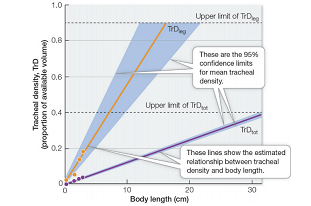
To analyze:
The limiting factor for the size of the insects, among the tracheal density of the leg or the tracheal density of the entire body by describing the graph shown below.

Introduction:
Insects belong to the phylum Arthropoda. The respiratory system of insects comprises spiracles and trachea. Spiracles are the small openings present on the exoskeleton of the insect. These openings are connected to the network of dense tubes called trachea or windpipe, which acts as the internal respiratory system for all the insects connecting pharynx and larynx to the lungs.
Explanation of Solution
The oxygen diffuses through the spiracles present on the exoskeleton and is further passed to the underlying tracheal tubes. The tracheal tubes branch into tracheoles that deliver oxygen to tissues and cells via diffusion. A study showed that level of oxygen in the atmosphere plays a crucial role in the body size of arthropods.
This leads to more tracheal density inside the insect’s body, which differs in legs as compared to the body, because larger the body of an organism, more is the tracheal network and tracheal density required to supply oxygen to all the internal tissues. However, from the graph, it is clear that as the body length of the organism increases, the tracheal density also increases in both body (TrDtot) and legs (TrDleg) but was found to be decreased or absent as both reaches the upper limit. Between both legs and body, density in legs was found to be more as compared to density in the body in small-sized organisms but its levels were found to be absent as the body length of organism increases.
The reason for the above observation is the concentration of oxygen, which is less in the atmosphere (21%). Thus small organisms is more efficient in intake of oxygen due to their small body size and tracheal density is sufficient to supply appropriate amount of oxygen. In large organisms, enhanced tracheal network is required to supply air to each organ of the body. But this does not cope-up with the present available oxygen levels as more oxygen in air (during Paleozoic times) allow minimum
Hence, it can be concluded that tracheal density in the legs is most limiting factor in the size of insects. This is so because large body length and size requires more tracheal network to transport air to all the tissues of body. Absence or less amount of trachea in legs of an organism shows the lack of oxygen supply in legs due to large body length.
Want to see more full solutions like this?
- 22. Which of the following mutant proteins is expected to have a dominant negative effect when over- expressed in normal cells? a. mutant PI3-kinase that lacks the SH2 domain but retains the kinase function b. mutant Grb2 protein that cannot bind to RTK c. mutant RTK that lacks the extracellular domain d. mutant PDK that has the PH domain but lost the kinase function e. all of the abovearrow_forwardWhat is the label ?arrow_forwardCan you described the image? Can you explain the question as well their answer and how to get to an answer to an problem like this?arrow_forward
- Describe the principle of homeostasis.arrow_forwardExplain how the hormones of the glands listed below travel around the body to target organs and tissues : Pituitary gland Hypothalamus Thyroid Parathyroid Adrenal Pineal Pancreas(islets of langerhans) Gonads (testes and ovaries) Placentaarrow_forwardWhat are the functions of the hormones produced in the glands listed below: Pituitary gland Hypothalamus Thyroid Parathyroid Adrenal Pineal Pancreas(islets of langerhans) Gonads (testes and ovaries) Placentaarrow_forward
- Describe the hormones produced in the glands listed below: Pituitary gland Hypothalamus Thyroid Parathyroid Adrenal Pineal Pancreas(islets of langerhans) Gonads (testes and ovaries) Placentaarrow_forwardPlease help me calculate drug dosage from the following information: Patient weight: 35 pounds, so 15.9 kilograms (got this by dividing 35 pounds by 2.2 kilograms) Drug dose: 0.05mg/kg Drug concentration: 2mg/mLarrow_forwardA 25-year-old woman presents to the emergency department with a 2-day history of fever, chills, severe headache, and confusion. She recently returned from a trip to sub-Saharan Africa, where she did not take malaria prophylaxis. On examination, she is febrile (39.8°C/103.6°F) and hypotensive. Laboratory studies reveal hemoglobin of 8.0 g/dL, platelet count of 50,000/μL, and evidence of hemoglobinuria. A peripheral blood smear shows ring forms and banana-shaped gametocytes. Which of the following Plasmodium species is most likely responsible for her severe symptoms? A. Plasmodium vivax B. Plasmodium ovale C. Plasmodium malariae D. Plasmodium falciparumarrow_forward
- Case Studies In Health Information ManagementBiologyISBN:9781337676908Author:SCHNERINGPublisher:Cengage
 Concepts of BiologyBiologyISBN:9781938168116Author:Samantha Fowler, Rebecca Roush, James WisePublisher:OpenStax College
Concepts of BiologyBiologyISBN:9781938168116Author:Samantha Fowler, Rebecca Roush, James WisePublisher:OpenStax College





